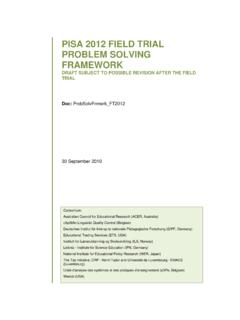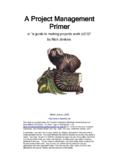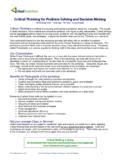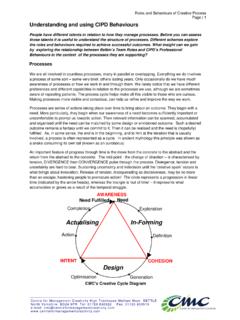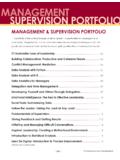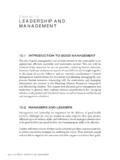Transcription of Creative Problem Solving for Managers: …
1 Creative Problem Solving for ManagersSecond editionHow can managers tackle complex problems?How do you encourage innovation?How do you implement new solutions?Is creativity the key to management success?This accessible text provides a lively introduction to the essential skills of Creative Problem extensive case studies and examples from a variety of business situations, Creative ProblemSolving for Managersexplores a wide range of Problem Solving theories and techniques, illustratinghow these can be used to solve a multitude of management revised and redesigned, this new edition retains the accessible and imaginative approachto Problem Solving skills of the first edition. Features include: Blocks to creativity and how to overcome them Key techniques including lateral thinking, morphological analysis and synectics Computer-assisted Problem Solving Increased coverage of group Problem Solving techniques New website containing in-depth cases and a PowerPoint presentationAs creativity is increasingly being recognised as a key skill for successful managers, this book will be welcomed as a readable and comprehensive introduction for students and practisingmanagers PProctoris Professor in Marketing at Chester University College Business School and wasformerly Senior Lecturer in Marketing and Head of the Department of Management at ProblemSolving for ManagersDeveloping skills for decisionmaking and innovationSecond editionTony ProctorFirst published 1999by Routledge2 Park Square, Milton Park, Abingdon, Oxon OX14 4 RNSimultaneously published in the USA and Canadaby Routledge270 Madison Ave, New York.
2 NY 10016 Reprinted 2002 (twice), 2003 Second edition 2005 Routledge is an imprint of the Taylor & Francis GroupAll rights reserved. No part of this book may be reprinted or reproduced or utilised in any form or by any electronic, mechanical, or other means, now known or hereafter invented, including photocopying and recording, or in any information storage or retrieval system, without permission in writing from the Library Cataloguing in Publication DataA catalogue record for this book is available from the British LibraryLibrary of Congress Cataloging in Publication DataProctor, Problem Solving for managers : developing skills for decision making and innovation / Tony Proctor. 2nd bibliographical references and Problem Solving . 2. Management. I.. 2005658. 4 03 dc222004020264 ISBN 0 415 34541 3 (hbk)ISBN 0 415 34542 1 (pbk)This edition published in the Taylor & Francis e-Library, 2006. To purchase your own copy of this or any of Taylor & Francis or Routledge scollection of thousands of eBooks please go to ContentsList of figuresxiPreface to the second editionxv1 CREATIVITY AND ITS IMPORTANCE IN BUSINESS1 Introduction1 Some definitions of creativity2 Invention and creativity3 Ideas and how they arise5 The importance given to creativity in business6 Conditions in which Creative thinking is required most10 Paradigm shift12 Characteristics of Creative thinking and Creative thinkers15 Questions19 Cases202 BLOCKS TO CREATIVITY23 Introduction23 The need to be ready for change24 Problem solving24 Mindset26 Other barriers to an individual s creativity29 Dealing with an individual s blocks to creativity29 Diagnosing whether someone is blocked in their thinking30 How techniques help to overcome blocks31 Blocks to organisational Creative thinking and ways of dealing with them34 Elements and conditions of
3 Creative organisations35 Questions36 Cases37v3 THEORIES OF CREATIVITY AND THE Creative Problem Solving PROCESS46 Introduction46 Creative thinking48 The brain as an information processor49 Convergent and divergent thinking52 The conditions of Creative thinking52 Problem solving55 Theories of Creative Problem solving56 The cognitive theory of creativity59 How we get ideas: the index metaphor61 Problem Solving mechanisms63 Analogical reasoning64 The Problem Solving process64 The Problem Solving process and the Creative process66 The Creative Problem Solving process67 Questions69 Cases694 OBJECTIVE FINDING, FACT FINDING AND Problem FINDING/DEFINITION72 Introduction73 Objective finding73 Fact finding76 Dimensional analysis77 Problem finding/definition79 Redefinition approaches81 Redefinition approaches: laddering84 Redefinition approaches: goal orientation85 Redefinition approaches: boundary examination86 Redefinition approaches: progressive abstractions87 Redefinition approaches: why method88 Analytical techniques: decomposable matrices89 Analytical techniques.
4 Cause-and-effect diagrams92 Questions92 Cases935 MORPHOLOGICAL ANALYSIS AND RELATED TECHNIQUES97 Introduction97 Checklists98 Attribute listing101 Morphological analysis103 Force-fitting triggers107 Heuristic ideation technique109 CONTENTSviComponent detailing111 Sequence-attribute modification matrix111 Questions113 Cases1146 BRAINSTORMING AND ITS VARIANTS118 Introduction118 Classical brainstorming118 The process of brainstorming121 Wildest-idea variant125 Stop-and-go brainstorming125 Round-robin brainstorming125 Gordon Little variation125 Trigger method127 Problems with brainstorming127 Brainwriting127 Brainlining128 Questions130 Cases1307 LATERAL THINKING AND ASSOCIATED METHODS137 Introduction137 Overview138 Awareness139 Assumptions141 Alternatives144 Provocative methods146 Metaphorical thinking152 Analogy153 The discontinuity principle155 Questions155 Cases1568 SYNECTICS160 Introduction160 Synectics160 Conducting synectics sessions165 Synectics in action170 Questions173 Cases174 CONTENTSvii9 PARADIGM-BREAKING TECHNIQUES AND SOME MISCELLANEOUS IDEATION METHODS179 Introduction180 Vision building180 Symbolic representation181 Miscellaneous ideation techniques185 Clich s, proverbs and maxims186 Storyboarding187 Scenario writing188 Scenario day-dreaming191 Bionics194 Two words195 Free association196 Story writing198 Mind map200 Lotus blossom technique203 Fishbone diagram204 Questions205 Cases20610 EVALUATION212 Introduction213 Sorting213 Evaluation methods216 Advantage disadvantage tables216 PMI: Plus/Minus/Interesting217 Castle technique218 Sticking dots218 Creative evaluation220 Force-field analysis220 Weighting systems221 The process of choosing222 Qualitative evaluation.
5 Reverse brainstorming224 Financial/mathematical evaluations226 Pay-off tables226 Decision trees227 Questions228 Cases22911 IMPLEMENTING IDEAS238 Introduction239 Ideas are not readily implemented239 Sources of resistance to change241 Role of communication in overcoming resistance to change242 CONTENTS viiiPutting ideas into practice243 Reducing resistance to change246 Climate for change251 Questions254 Cases25512 COMPUTER-ASSISTED Creative Problem SOLVING258 Introduction258 History of development259 Structured approach to Creative Problem Solving in computer programs260 Types of program261 Group Creative Problem Solving aids266 Conventional software267 Questions269 Cases270 Appendix to chapter: notes on some creativity programs270 Bibliography277 Author index284 Subject life-cycle Solving according to Newell and Simon (1972) s blocks to are 1996 coins worth more than 1984 coins? the aircraft flying towards you or away from you?
6 Broken clock of the theories: the Whole Brain conditions of index Creative Problem Solving of this chapter within the CPS of the toy manufacturer reviews its marketing position and of Problem finding the situation Problem situation Problem situation Problem situation Problem situation Goal Boundary Progressive Why Decomposable Hierarchical sub-systems of a motor A decomposable Cause-and-effect of this chapter within the CPS technique to use? listing for a in morphological triggers triggers triggers ideation Component Sequence-attribute modification of this chapter within the CPS of some brainstorming brainstorming Little of this chapter within the CPS nine dots of this chapter within the CPS synectics process: fantasy excursion synectics process: example excursion of this chapter within the CPS methods illustrated in the that can be used in Problem in rich s, proverbs and Scenario Two Structured free Story Overview of graphical methods illustrated in the Mind map of computer software used in Mind map of whom to The lotus blossom Fishbone Cognitive Position of this chapter within the CPS Overview of the process of sorting and Mind map of ideas on the uses of aluminium Castle Sticking dots Sticking dots method.
7 An Force-field The choice Reverse Decision Position of this chapter within the CPS Overview of acceptance An illustration of the use of the Decision Explorer(COPE) chart using Time Line for Windows Simulation of the coronary artery deficiency treatment process in a UK hospital using The stages in CPS covered by this An overview of the ways in which computers can help in the Creative thinking Sensitivity analysis with a spreadsheet268 FIGURES xiiiPreface to the second editionI began the first chapter of a book I wrote some years ago called The Essence of Management Creativityby saying it was about creativity and Problem Solving in management. This book, too,follows a similar theme, but I have expanded my ideas somewhat since I wrote the other am often asked whether the various approaches I outline in this book really answerto this, I feel, is really only known by those who use the methods.
8 Moreover, it is always difficultto know if you would have been able to find an answer to a Problem which you did not knowexisted without the aid of the techniques I outline here. Or, indeed, for that matter, whether youmight solve the Problem more to your satisfaction by using other material contained in this book should appeal to a wide audience. I originally thought the subject matter was something which would perhaps most interest experienced and matureadults. I discovered that not only was it something which appealed to experienced managers but it also held the attention of management students of all ages and backgrounds. One of my most enlightening experiences has been getting final-year undergraduates interested in the subject matter of this book will appeal to people who have a variety of different interestsin management. Whether your primary interest is in accounting, personnel management,marketing, production, research and development, and so on, does not really matter since thesubject matter contained in this book is relevant to all these interests.
9 However, you must approachthe subject with an open mind; and all the methods, no matter how ridiculous they may seem,should be treated seriously but not so seriously that they cannot be greatest barrierto appreciating the subject matter of this book is book first sets the scene for management creativity. It explains what creativity and creativeproblem Solving are thought to be. It then considers why creativity management is considered tobe various blocks to Creative Problem Solving are explained, as are the actions thatare required to get around these difficulties. A chapter outlines some of the most recent ideasrelating to creativity and Creative Problem Solving . This chapter is important since it provides abackground and explanation for many of the steps in the Creative Problem Solving process whichare considered in subsequent chapters. Each step in the Creative Problem Solving process is exploredin some depth, and illustrations are given of some of the principal mechanisms used to helpstructure and stimulate final chapter is given over to considering how interaction withcomputers can help to stimulate Creative Problem the book there are ample illustrations of the key points.
10 There are specific casestudies attached to each chapter and an additional set of case studies on the website: The latter invite the reader to make use of all theknowledge he or she has gained about the Creative Problem Solving process through reading the would like to express my thanks to Dr Ioanna Papasolomou of Intercollege, Cyprus, and Dr Rosmimah Mohd-Roslin of the MARA University in Malaysia, for their contributions of case-study material. My thanks also to Dr Elspeth McFadzean for her thoughts that techniquesmight be considered in the light of whether they are useful in paradigm preserving,paradigm stretchingorparadigm Proctor, 2004 PREFACE TO THE SECOND EDITIONxviChapter 1 Creativity and its importance in businessINTRODUCTIONIn this chapter we shall review some definitions of creativity and highlight the importance ofcreative Problem Solving in enabling business executives to cope with novel or new some consideration first to defining creativity and then to distinguishing between creativityand notions exist on how ideas arise in our are introduced in thischapter and developed further in Chapter 3.
